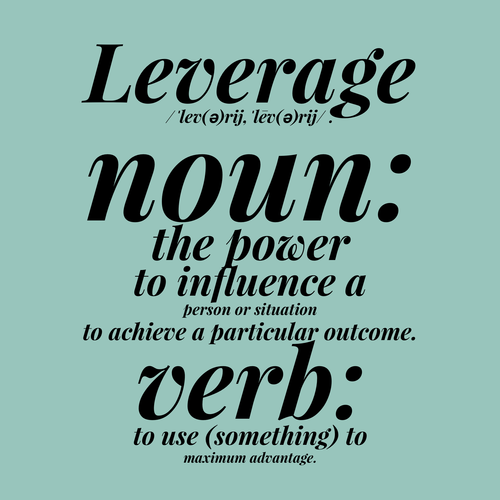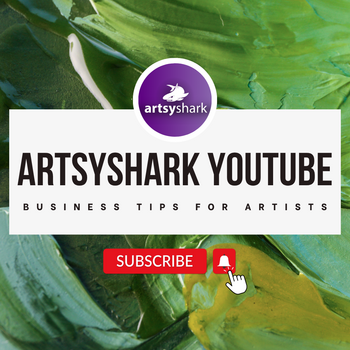by Carolyn Edlund
Work more efficiently, increase your opportunities and close more sales by using leverage.

“Work Smarter, Not Harder” is a popular phrase that encourages us to take a strategic approach to doing business. This might involve becoming more efficient, or deciding to say No to projects that don’t align with our goals. But working smarter often means that you leverage what you have to magnify your results.
Leverage is defined as: “the power to influence a person or a situation to achieve a particular outcome” or “to use (something) to maximum advantage.” Some things artists can leverage include their background, connections, knowledge, and even their body of work.
How One Artist Used Leverage
Sports artist Steven Lester leveraged the fact that he was a graduate of a southern university to pitch them on painting images of their stadium. Because he was an alum, they were open to meeting with him and ended up commissioning the painting. The artist was able to leverage the situation multiple times to maximize the impact of that connection and sale.
“Most artists focus on their product, but you must also focus on your people and your process,” said Lester. “That’s where leveraging comes in. The commission was just the beginning. I knew from my business background that the way to get my work into a university was to get in front of the people who were fundraising, who use premium gifts as a strategy. They asked for the rights to license the image and produce 250 limited edition prints to be hand-signed and given to major donors.”
After that agreement was made, Lester suggested printing 50 larger giclees on canvas. Each sale would pay a portion to the university. “This is how I leveraged one idea and one image to scale that initial concept into lots of sales, plus income for my client,” he explained.
Lester then leveraged his success in landing that commission by reaching out to other colleges for the same purpose, buffered by a strong referral from the original client. This enabled him to turn sale after sale as he built a strong portfolio geared towards college sports that earned him a solid reputation and made him a “go to” artist.

Artist Steven Lester signs limited edition prints to be used as premium gifts for donors.
Leverage Current Events
Do you have a concept or work in your portfolio that relates to high-profile news or issues? Digital artist Deb Minnard had created a portrait of Harambe, a gorilla at the Cincinnati Zoo, which was in her portfolio. When a child fell into the gorilla’s enclosure, resulting in the animal being shot and killed, the news story went national. Minnard contacted the press with her portrait, and also donated a print to the zoo. Her image and story were picked up by news outlets, pushing the visibility of her work to a wide audience.
News stories are often short-lived, but others become long-term discussions that go much deeper, with major social implications. Artist robin holder’s life’s work is about racial inequity and division, with the goal of opening communication and moving toward healing. Her voice, and her art, is highly relevant today. Through regular outreach, she has been able to leverage her art world contacts to gain a significant number of inquiries and opportunities.
Leverage Your Art
Making art once and selling it over and over is a way of leveraging that allows you to “scale” your business and grow it exponentially. Artists can do this in a number of ways.
Producing reproductions of your art allows you to capitalize on the original image. This is a common strategy. Reproductions can be held as inventory and sold directly, or offered as print-on-demand products.
Licensing is another way to leverage your body of work. Artists who use this business model grant a third party the right to use their images, without conveying copyright. A licensing agreement sets the parameters: the images to be licensed, the specific products to be made, a time limit on the contract, and royalties to be paid to the artist. Benefits include an additional (mostly passive) stream of income and greater exposure in the marketplace.
Working in production is another way to leverage your art. A potter who designs a mug and makes multiples in the studio in preparation for a festival is leveraging the original design for retail purposes. That same artist could take their business to a new level by entering the wholesale marketplace, where they can really scale. Collections are designed and marketed to store buyers, who place volume orders at wholesale prices. This business model improves efficiency and thrives on repeat sales, which leverages your customer base.
Leverage Your Collectors
If you are an artist who prefers to create only originals, leverage your collectors by selling to each of them more than once. Existing customers are the best prospects for future sales. By staying in touch closely with their collectors and fans, you are more likely to make those repeat sales.
Artists who build their business on a foundation of strong relationships are in a position to use leverage more easily. Your network is a valuable asset that can lead to more opportunities and increased sales when used wisely.




Speak Your Mind